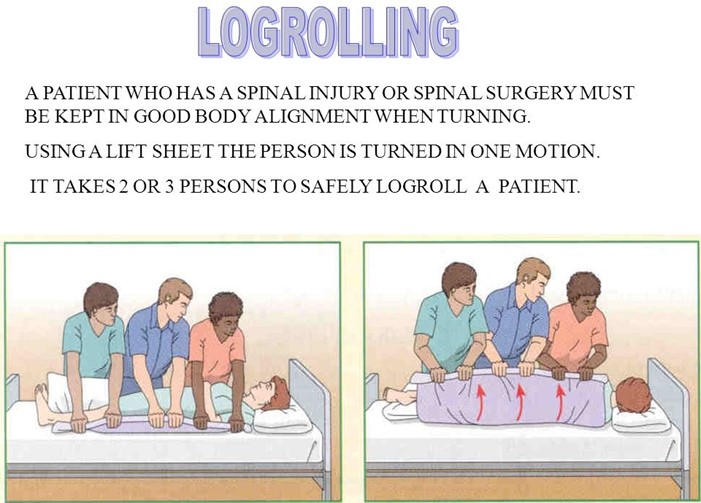Immediately after log-rolling a client to a lateral position, which intervention should the practical nurse (PN) implement?
Raise the head of the bed 30 degrees.
Measure blood pressure and pulse rate.
Flex legs and place blanket between legs.
Place pillows to maintain alignment.
The Correct Answer is D
Log-rolling is a technique of moving a client as a unit without twisting or bending the spine, which is used for clients with spinal injuries or surgeries. After log-rolling a client to a lateral position, the PN should place pillows to maintain alignment and prevent pressure ulcers or nerve damage. The pillows should be placed under the head, neck, upper arm, chest, abdomen, pelvis, and lower leg.

The other options are not correct because:
A. Raising the head of the bed 30 degrees is not necessary or appropriate after log-rolling a client to a lateral position, as it can cause shearing forces or compromise the spinal stability. The head of the bed should be kept flat or slightly elevated during log rolling.
B. Measuring blood pressure and pulse rate is not the immediate intervention after log-rolling a client to a lateral position, as it does not ensure the comfort or safety of the client. The PN should monitor the vital signs before and after log-rolling, but not during or immediately after.
C. Flexing legs and placing a blanket between legs is not the immediate intervention after log-rolling a client to a lateral position, as it does not support the spine or prevent pressure ulcers or nerve damage. The PN should keep the legs straight and aligned with the body during log-rolling, and place a pillow under the lower leg after log-rolling.
Nursing Test Bank
Naxlex Comprehensive Predictor Exams
Related Questions
Correct Answer is B
Explanation
A. Enrolling the UAP in a hospital education class on conducting safe client care is unnecessary at this moment. The immediate concern is ensuring the client's safety during the procedure.
B. Stopping the procedure and instructing the UAP to place the client in Fowler's position (or at least semi-Fowler's) is the correct action. This position helps prevent aspiration during oral hygiene for an unconscious client.
C. Praising the UAP for performing oral hygiene does not address the safety risk present in this situation. While family participation is encouraged, it should not be the focus here.
D. Telling the UAP to continue because the unconscious client is positioned safely is incorrect, as the flat side-lying position increases the risk of aspiration. Ensuring the client is positioned properly is essential for their safety.
Correct Answer is C
Explanation
A) Incorrect- While understanding the frequency that a problem occurs can provide context to its significance and potential impact, it is not the most important consideration when gathering evidence for evidence-based decision-making. The frequency alone does not ensure that the evidence collected will be directly applicable to the current situation.
B) Incorrect- Personal values are subjective and may influence an individual's perspective, but they are not the primary consideration when gathering evidence for evidence-based decision- making. Evidence-based practice aims to rely on objective and scientifically validated information rather than personal values, which can vary greatly among individuals.
C) Correct- The most important consideration when gathering evidence is its relevance to the specific situation at hand. Evidence must directly address the problem and clinical question, ensuring that the information collected is applicable, appropriate, and reliable for guiding decision-making in the current context.
D) Incorrect- While past experiences can offer insights, they are not the most important consideration for evidence-based decision-making. Relying solely on past experiences may not account for new developments, changing guidelines, or unique aspects of the current situation that were not present in previous encounters.
Whether you are a student looking to ace your exams or a practicing nurse seeking to enhance your expertise , our nursing education contents will empower you with the confidence and competence to make a difference in the lives of patients and become a respected leader in the healthcare field.
Visit Naxlex, invest in your future and unlock endless possibilities with our unparalleled nursing education contents today
Report Wrong Answer on the Current Question
Do you disagree with the answer? If yes, what is your expected answer? Explain.
Kindly be descriptive with the issue you are facing.
